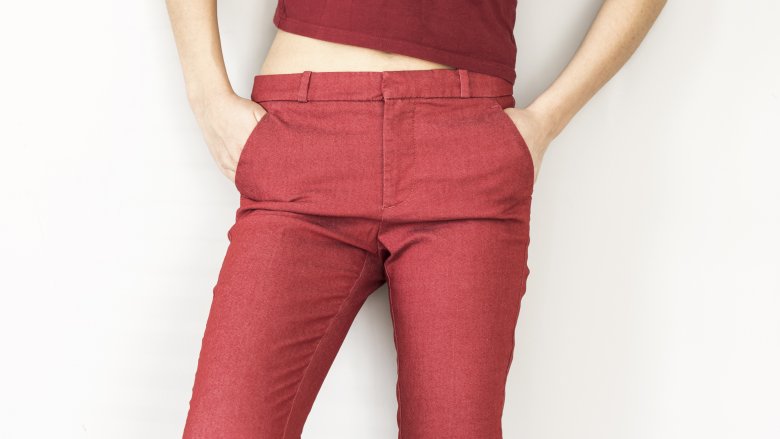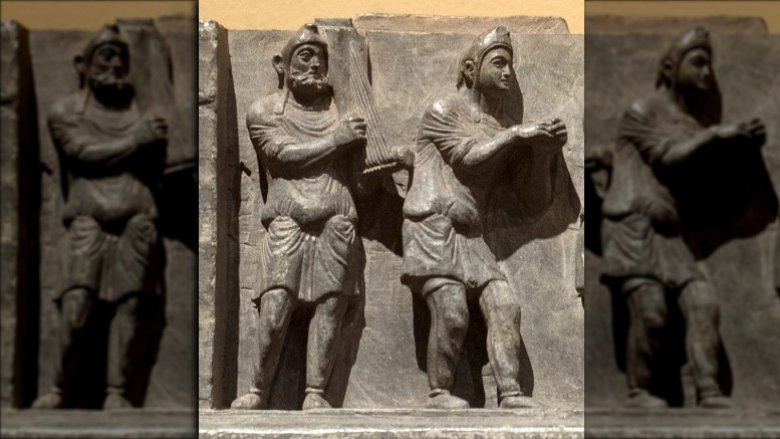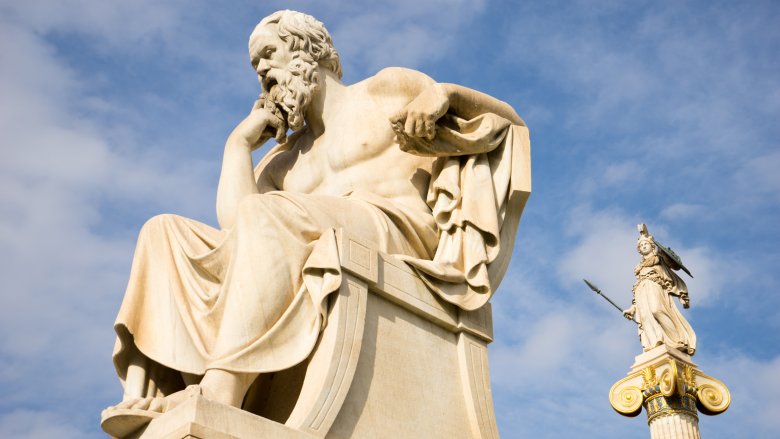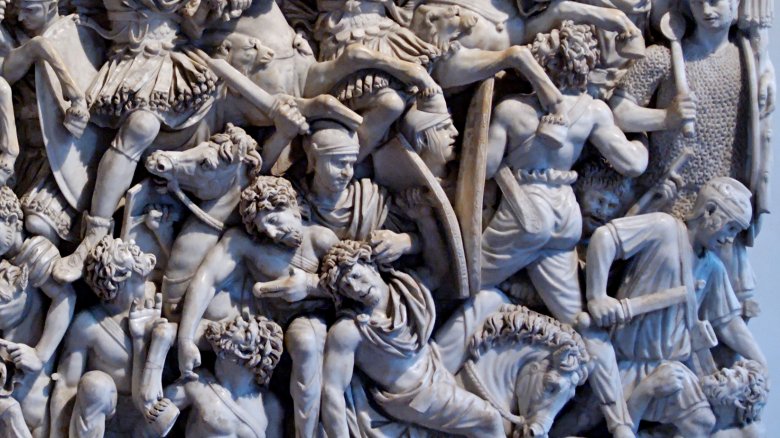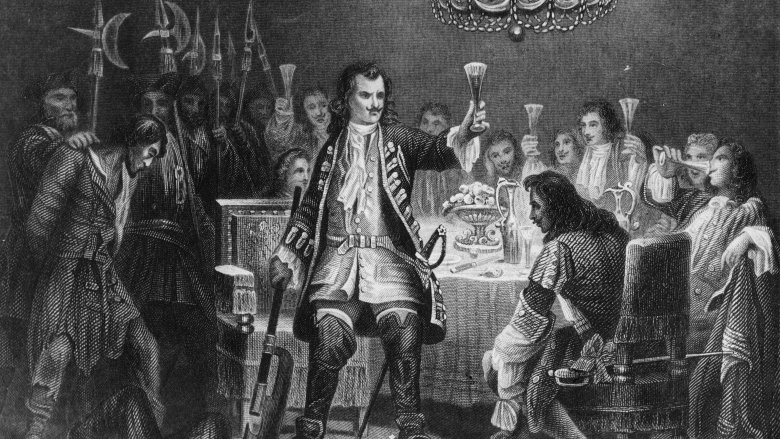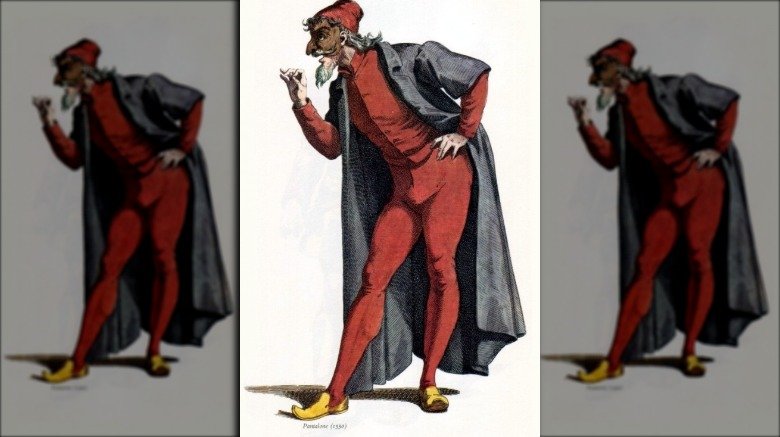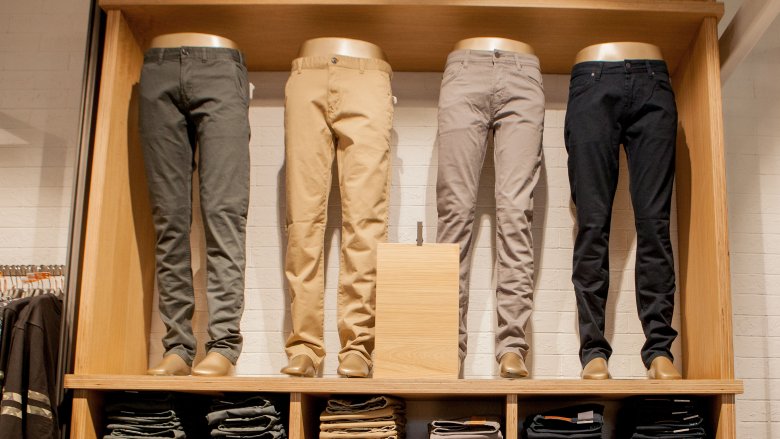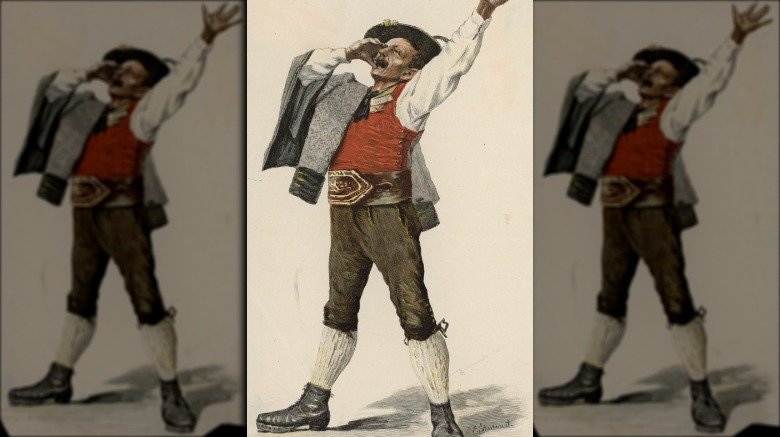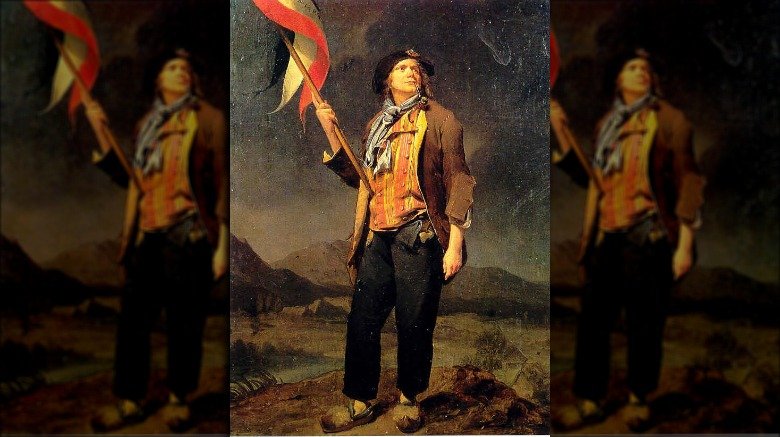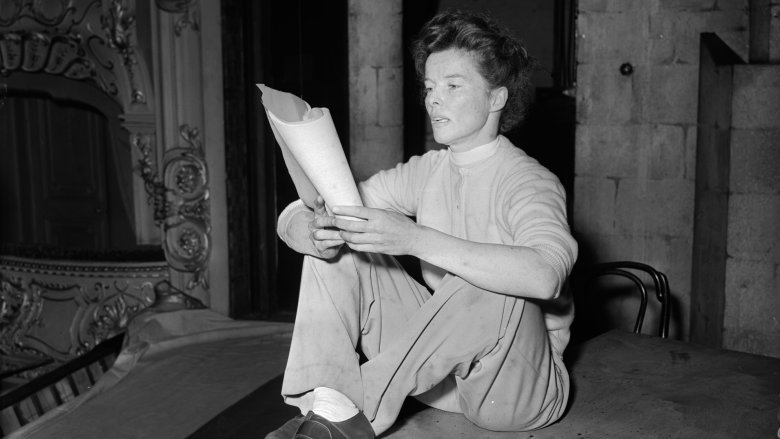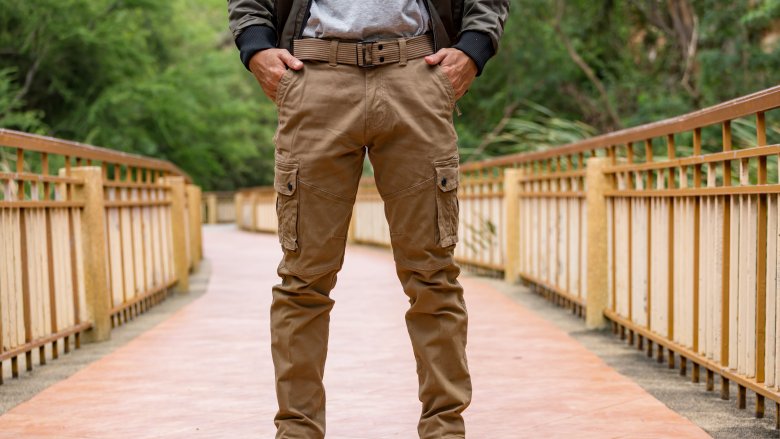The Intriguing History Of Why We Wear Pants
If you close your eyes and picture a person from a well-known ancient culture of Europe or the Near East — the Greeks, the Romans, the Egyptians, the Israelites, and the other ancient cultures that have had the biggest impact on modern Western culture — there is probably one notable difference between you and the person you're picturing. Well, okay, lots more than one. The Agrippa or Zeno you're picturing probably isn't dropping hot takes on Twitter while slamming a bag of pizza rolls, but there's maybe one really obvious surface difference: You're wearing pants and they aren't. (Okay, again, if you're currently scrolling Twitter and doing pizza rolls you might not be wearing pants at this exact moment, but, like, at some point during your week you probably had your leg touch the inside of a pant. Even if just a pajama pant.)
How did we as a culture get from wearing tunics, robes, gowns, and togas to cargo shorts and mom jeans? How did pants go from being a sign of barbarism to being one of the only requirements to eat at a Waffle House? And why do we call them pants? Why do we call them a pair of pants? All these questions and more answered within, so hike up your britches and let's go!
The dawn of pants
So what was it that led to the invention of pants? Tunic- and gown-wearing ancients must have had an overwhelming pile of cultural and practical reasons to abandon that breezy, free-flowing feeling enjoyed still today by those who wear dresses, skirts, kilts, and bathrobes in favor of wrapping each leg individually and then joining those leg-sheaths with a crotch-hugging, fart-catching section in the middle, right? Just, like, a bunch of reasons for pants, right? Well, no. A lot of it comes down to horses.
As Science News explains, the oldest known pants come from Central Asia between 3,000 and 3,300 years ago, among nomadic herding cultures who found pants the best option for riding horses. Horse riding's origins are somewhat shrouded in mystery, but it might go back as far as 4,000 years, and pants probably didn't lag too far behind. The oldest pants so far discovered are from China's Tarim Basin, but pants were also worn by other nomadic equestrian cultures like the Scythians about 2,500 years ago. These early pants were straight legged with a wide crotch, sewn together from wool cloth with slits on the side, a string fastener, and decorative weaving in the legs. Interestingly, the Tarim Basin pants seem to have been woven to their final size with no cutting involved in their shaping. No word on whether the first pants-wearer's mother embarrassed him in front of the entire nomadic shopping mall by making him come out of the dressing room and turning around to show how they fit on his butt.
Pants of the barbarian
The ancient Greeks were not a pants-wearing people. They didn't like them. Instead, they tended to wear long, flowing linen or wool garments that were belted or pinned in place. Men usually wore a linen tunic called a chiton (not a toga), over which they might wear a wool cloak called a himation (also not a toga) in the winter. Women wore tunics pinned at the shoulder called a toga. No, just kidding. This was called a peplos. Romans copied the Greeks in clothing as they did in mythology, architecture, philosophy, and so many other things, and so men wore knee-length tunics belted at the waist, while women wore an ankle-length tunic belted at the waist and under the breast called a stola (not a toga). Male citizens, usually in formal situations like going to work in the Senate, would sometimes wear a giant wool cloth about 18 feet by 6 feet that they would wrap and drape over their tunics. That is a toga.
Greeks hated pants because, as Vintage News explains, they thought they were ridiculous, but also because they associated them with foreigners. Pants were what Persians, Scythians, and other Asian people wore. They were the clothes of barbarians, not a civilized Greek. The Romans, of course, followed the Greek attitude on pants. The Latin word bracatus, which literally means "wearing pants," was used to refer to people that Romans thought were foreign, barbarous, and — perhaps ironically given our modern view of pants — effeminate.
Forbidden pants of the Roman Empire
As Atlas Obscura points out, Roman hatred of pants was pretty much just straight up racism, with the circular logic that pants were not sophisticated because sophisticated people don't wear pants. When the great Roman orator Cicero wanted to condemn the behavior of the Gauls, he referenced "their military cloaks and their breeches" as signs of their innate aggression.
However, by the time of the early empire, Roman soldiers were suddenly discovering that the swishy potato sacks with armholes that worked so well in a Mediterranean climate weren't up for the job of retaining territory in Germany, Switzerland, Britain, and elsewhere. Taking cues from their new Gaulish allies, Roman soldiers began wearing pants to protect their borders from the Goths. Before long, this military fashion caught on with civilians as well, and by 397 C.E. in the waning days of the Roman Empire, brothers and co-emperors Honorius and Arcadius issued a decree banning civilians from wearing pants from the capital. This was meant to serve the dual purpose of firming up Roman cultural identity (i.e., curtailing the War on Togas) and making it easier to distinguish soldiers from civilians among an assassination-happy populace.
Bad news for the Romans meant good news for pants: The trousers ban ended when Alaric and his pants-wearing Visigoth army sacked Rome, more or less making the fall of the Western Empire in 476 inevitable. The Eastern Empire kept on, however, and by a century later, pants were the official fashion of the court for the Byzantines.
The mandatory pants of the Russian Empire
In a complete 180 from the pants ban of emperors Honorius and Arcadius in the late Roman empire stands the mandatory pants reform of Peter I of Russia — better known as Peter the Great — in the 17th century. Where for the Romans pants were a symbol of barbarism and otherness that needed to be wiped out, for Peter they were a sign of civilization and modernity that needed to be brought in at any cost.
When Peter became sole tsar of Russia in 1696, the country hadn't progressed much in about six centuries. The isolationist tsardom was ruled by a wealthy class of nobles called boyars, who, together with the crazy powerful Orthodox church, maintained their wealth and power thanks to an enormous, powerless serf class. The fashion of choice was long robes, long coats, and long beards. However, Europe of this time was experiencing an explosion of progress in technology and trade and was soon knocking on Russia's door. Peter had been raised by a Western-educated mother and had himself traveled through Enlightenment-era Europe and soaked in their culture (in disguise! Peter was a fascinating dude) and he was determined to drag Russia kicking and screaming into the 18th century.
A major element of his modernization efforts was wardrobe reform, which meant robe-wearing boyars suddenly found themselves forced to wear pants and other Western-style outfits (and shave their beards) under penalty of a hefty fine if they tried to enter Moscow. Peter's reforms met a lot of resistance, but pants (and modernization) won out in the end.
Pants' comedic roots
The word "pants" is, let's admit, pretty funny. It's probably funnier for speakers of British English, for whom "pants" generally refers to underwear rather than outerwear. It's a funny enough word that since the 1990s British English speakers (and some other English speakers, for that matter) have used it to mean something ridiculous or nonsensical, as in "The whole idea of fashion is pretty pants." Some of the potty humor of it is retained in American English, too, thanks to compounds like underpants and panties. Just say it: pants. Pretty funny.
Anyway, it turns out that comedy is in the very DNA of the word pants, so maybe that's why it's so funny. You're the smart and inquisitive kind of person reading a history of pants on the internet, so you probably already know that the word pants is short for pantaloons, but what you might not know is that pantaloons is an Anglicization of the Italian word Pantalone. Pantalone, in turn, was a character in the hugely popular Renaissance-era Italian comic theater known as commedia dell'arte. As Merriam-Webster explains, Pantalone (above) was a "greedy, lecherous, scheming old man who often ended up being duped and humiliated," and who could be recognized by his costume, which included a brimless hat, an open black cassock, and, yeah, long trousers. When a similar style of pants became popular in Restoration England, they named their new fashion after the comedy character famous for his pants, like how super-short cutoff jeans would later be called Daisy Dukes.
Pants by any other name
While pants is the generic term for a garment worn from waist to ankles while covering each leg separately in American English, the preferred term for such a garment in British English is trousers (pants are generally underwear in the United Kingdom). The word "trousers" can be traced back to the Gaelic word triubhas, meaning "close-fitting shorts," which by the 1570s could be found in English as trouse and then trouzes a decade later. The "r" at the end probably got added by the influence of drawers and other words described as "a pair of ______" like tweezers and pliers (more on that later). The Online Etymology Dictionary also indicates that in early days trousers were regarded as Celtic, giving the eyebrow-raising sample sentence from 1630, "A jellous wife was like an Irish trouze, alwayes close to a mans tayle." That dude sounds like he needs to learn to keep his trouze on and stop chasing tayle.
But even in American English, where it's not the generic term, trousers can be heard in certain contexts. Specifically, trousers is used to mean a tailored pair of pants with a waist band, belt loops, and a fly front. Slacks, meanwhile, indicate less formal, untailored, usually off-the-rack dress pants, which are often made of smooth wool knits, which tend to hang — wait for it — slack. Khakis are dress-casual pants, usually (but not always) light tan in color, chinos are flat-front dress pants often light beige in color, and then there are jeans, but hopefully you know what those are.
Don't get your knickers in a twist
Before the full-length, open-legged trousers we know today became the default form of pants, European pants took multiple different forms whose names will probably make you say, "Ah yes, I recognize these as old-timey words for pants." Namely, these are breeches, pantaloons, and knickerbockers.
Prior to the late 16th century, the main term for leg coverings was hose, which were generally separate coverings for each leg joined by a codpiece, but these were replaced by breeches, which were a single, sewn-together garment. Breeches usually ended right below the knee or midway down the calf, with either boots or stockings worn below if a gentleman wanted to show off his sexy leg day gains. Breeches fell out of fashion by 1820 and were replaced by pantaloons, which were slimmer fitting and reached down to the ankle, meant for the skinny jean set, though even then there were caricatures of thicc boys trying to pull them off. By the 1840s, looser fitting trousers replaced the tight pantaloon, inspired by sailors who popularized the look. But knee-length pants saw a resurgence in popularity in the 20th century in the form of knickerbockers, which are baggy-kneed pants that end at or just below the knee. These were popular for young boys in the early 20th century, and remain popular today for sports uniforms, such as for baseball (though they are less baggy these days), football officials, and those funny golf pants (called plus fours, because they extend 4 inches below the knee).
France's No-Pants Army
Never has the difference between two styles of pants been bloodier or more political than during the French Revolution. No, not even during the great Zubaz vs. JNCO wars of the 1990s. The militant radical partisans of the lower-class common people of France during the French Revolution and Reign of Terror were known as sans-culottes, meaning "without breeches." This might make you picture a much sexier (or alternatively, more Donald Duck-like) revolution than actually occurred until you realize that "no breeches" doesn't mean they didn't wear any pants, just that they didn't wear a specific kind of pants.
"Culottes" in this instance refers to knee-length silk breeches favored by the aristocracy and bourgeoisie of the Ancien Regime against whom the rebels were rebelling. The working class radicals who would come to be known as the sans-culottes wore ankle-length pantaloons or trousers, as well as a short jacket known as a carmagnole, the red Phrygian cap known as the cap of liberty, and wooden clogs called sabots. (Fun, non-pants-related sidenote: This type of shoe is the origin of the word sabotage, which originally has the sense of bungling a thing, like someone walking loudly and clumsily in wooden shoes.)
Anyway, the sans-culottes were the radicals who called for the executions without trial that led to the Reign of Terror, so definitely not as cute and charming as "there's an army in France and they don't wear any pants" might have you believe. Still, the association between knee-breeches and aristocracy stuck, which caused them to fall out of fashion in the 1800s.
The rise and fall and rise of women's pants
Pants, of course, have for most of history been considered men's clothing, but hey! Pants are for everyone! In the early 1850s, a women's rights advocate named Amelia Jenks Bloomer suggested as "rational dress" for women a costume made up of a short jacket and a knee-length skirt under which would be worn loose, ankle-length trousers. While the full costume didn't last, loose-fitting women's trousers, once very popular for women to wear while bicycling, and of course women's baggy underwear would continue to bear the name bloomers after their most prominent advocate.
The fight to make pants a gender-neutral garment in Europe and America has been a long one. It was technically illegal for women to wear pantalon in Paris thanks to the violent reputation of the sans-culottes. In the 19th and early 20th centuries, pants became a more common accessory for some working women, including coal mine workers known as pit brow lasses and pilots. Designers started making pants for women, and they began being considered leisure wear, but women wearing pants in public could still cause a scandal, as happened with actress Katharine Hepburn. Fortunately, World War II helped to normalize the idea of women wearing pants thanks to them becoming common for women working in factories during that time, and even though the progress has not been quick or steady or even unidirectional, it has become much more the norm for it to be cool for women to wear pants when they wanna.
Why a pair?
Here's a thing that confuses even native speakers of English: Why do you call them "a pair of pants"? It's only one thing. "Two pairs of pants" sounds like it's describing four things, when in fact it is only two. One popular explanation tries to justify this by saying that in ye olden dayes when pants were pantaloons, they were actually two separate things where you put one on each leg and then fastened them in the middle. Readers who have been paying attention, however, will note that while this describes medieval hose, this is not true of even the earliest pantaloons.
Britannica says nah, too. According to them, there's not really any evidence to support the two-piece pants theory. The fact is, pants is just a linguistic phenomenon known as a plurale tantum, which is Latin for "plural only." English has no shortage of such words. Examples include electronics, odds, surroundings, and thanks. However, English is especially fond of making pluralia tantum out of bifurcated items, that is, items that split or divide cleanly into two symmetrical halves. Pants are a natural fit, with their two legs that meet in the middle, as are scissors, tweezers, pliers, glasses, and — ahem — genitals. You never say "a scissor," "a plier," or "a genital," and you can only get away with saying "a trouser" if you're Tim Gunn. Also, all of these are described as being a pair despite being technically a single item. Pants aren't that fancy. Unless, of course, they're fancy pants.
